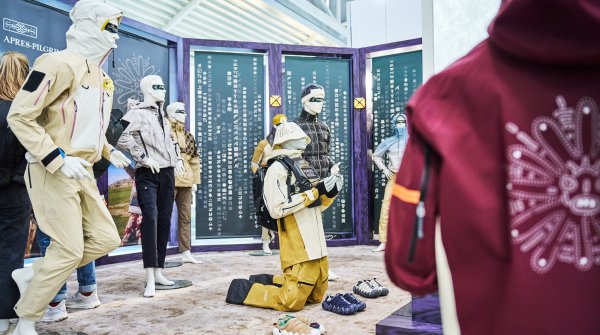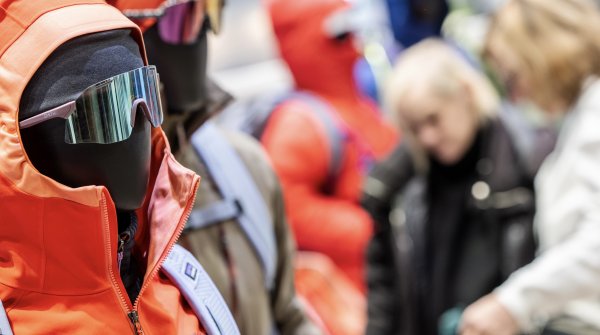
However, current figures show that China's inhabitants are playing more and more sports and sales of sporting goods are skyrocketing. In 2022, sales in the industry are forecast to reach around 57 billion euros, compared to just 36 billion in 2016. The market is currently dominated by monobrand stores, but the multibrand concept is slowly catching up.
Impressive figures - and thus reason enough for ISPO.com to have an in-depth conversation with Robin Trebbe, Managing Director China and Asia Pacific for Intersport , during ISPO Shanghai 2018 on the topic of multibrand in China.
ISPO.com: Mr. Trebbe, could you briefly summarize the current situation for multibrand retail stores in China and Asia at the beginning of the conversation?
Robin Trebbe: At the moment, Asia - and China in particular - are very monobrand dominated. In numbers, 95% of the market in China is monobrand retail stores. Adidas alone has 11281 stores in China. The only exception in the Asian region is Japan, which already has a grown market. Nevertheless, the multi-brand trend is developing steadily.
What do you think are the reasons for the positive development of the trend?
Especially in China, I would say that people are more intensively involved with sports. Knowledge and experience are increasing, especially in the running and fitness sector. In the beginning, sporting goods products served their own image. Now consumers actually want the best possible running shoe so they can actively use it for running. So it's no longer about the most beautiful shoe of brand XY, but about the best product for the respective customer. In short: function is more important than design. They can only get the appropriate selection in a multibrand retailer store, where it is possible to compare products against each other.
That all sounds very logical, but consumers' habits often change very slowly. What strategies do you intend to use to speed up this process?
Our goal must be to make it clear to consumers that we offer them clear added value. After all, we ultimately sell all the brands that are in demand and also offer the option of foot and running analyses, for example. In addition, we can set seasonal and event-related focal points: Soccer World Cups, the start of the NBA season or in summer swimming can be highlighted as sports for a certain time in our stores. It's one-stop shopping for the whole family. Of course, there will always be people who favor a particular brand and shop at the flagship store accordingly. But the number of people who place function and range above design and brand is growing steadily.

The sheer numbers speak for you, and yet the number of multi-brand stores is not that large. Would you say that this is the perfect moment for retailers to join forces?
I think we can all learn from each other. The potential in China is huge, and sharing ideas and experiences is immensely helpful. What does a multi-brand store have to look like? How does marketing work? What are omni-channel services? All these questions have long been answered in Europe and North America, but the answers cannot be transferred 1 to 1 to China, because in China there was virtually only monobrand and no multibrand. The opposite trend is currently taking place in Europe and North America, where multibrand has dominated the market and monobrand stores are now clearly on the rise.
How important do you think trade shows like ISPO Shanghai are for the multibrand business?
For me, as the person responsible for the entire Asia-Pacific region at Intersport, it's first of all a perfect opportunity to meet with the most diverse brands. So it saves an incredible amount of time. In addition, it gives me the opportunity to network with my colleagues from the industry and at the same time discover new trends - which may subsequently be considered for our stores.
To what extent do you use the forums and panel discussions offered at the trade show to get new impetus for your business?
Personally, I make extensive use of these offerings because I get to see best-practice solutions presented first-hand. The Running Forum, for example, is extremely interesting, as it is one of our core areas.

On the subject of e-commerce: How difficult is it to prevail in China against big players like Tmall or JD?
First of all, it has to be said that the online landscape in China is somewhat different from what we know from our classic market in Europe. Alibaba and Tmall dominate the entire Asia-Pacific region, but at the end of the day we try to implement our off-line principle online as well. So one-stop shopping with a comprehensive brand offering, plus extra benefits that a consumer doesn't get in a monobrand store.
Offline and online are increasingly merging into a holistic approach, which Intersport is trying to reflect with new stores. What is so special about these new stores?
The store opened at the end of May 2018 is the first "Intelligent Retail Store for Sport and Fashion. We were chosen by Alibaba as a cooperation partner in this, and I have to say the store has some impressive tools. For example, there are interactive games in the windows to bring consumers into the store. Another feature is QR codes that once scanned provide a shopping voucher for the customer. The response from both customers and brands has already been extremely positive and we will continue to implement the concept to a certain extent in the future.
Is this inevitably the future of shopping?
I think so. Before the customer physically enters a store, he searches the Internet for store opening hours, how to get to the store the fastest, and he probably also checks the brand offerings. This behavior is exhibited by around 80 percent of consumers. So if a store is not stored on Google Maps or Baidu, it simply doesn't exist. Features like "click and collect" are actually already a thing of the past, but the future belongs to the ideas of Alibaba and founder Jack Ma.
There is, of course, a constant exchange between the Swiss headquarters and myself, whereby we also use the "Magic Mirror" tool in Europe, for example (here, customers can call staff in fitting rooms for advice). In addition, topics such as electronic payment models or deliveries directly to the customer are much more developed in China for a variety of reasons. In these areas, Europe and North America are learning from China and not the other way around.
Offline and online are increasingly merging into one holistic approach, which Intersport is trying to depict with new stores. What’s so special about these new stores?
The store we opened in late May 2018 is the first “Intelligent Retail Store for Sport and Fashion.” We were selected for this by Alibaba as a cooperation partner, and I have to say that the store has some impressive tools. On the one hand, for example, there are interactive games in the shop windows to bring consumers into the store. Another feature are QR codes which, once scanned, provide a shopping voucher for the customer. The response from both customers and brands is already extremely positive, and we will continue to implement the concept to a certain extent in the future.
Is this the inevitable future of shopping?
I think so. Before the customer physically enters a store, he or she searches the Internet for store business hours, the quickest way to get to the store, and probably also checks the brands on offer. Around 80 percent of consumers follow this behavior. So if a store isn’t listed on Google Maps or Baidu, it simply doesn’t exist. Features like “Click and Collect” are already a thing of the past again, while Alibaba and founder Jack Ma’s ideas belong to the future.
Naturally, there’s a constant exchange between the Swiss headquarters and me. We also use the tool of the “Magic Mirror” in Europe, for example (here, customers can call personnel for advice in changing rooms). In addition, topics such as electronic payment models and direct deliveries to customers in China are much more advanced, for a variety of reasons. In these areas, Europe and North America can learn from China, and not the other way around.
 Sports BusinessSustainable ideas for store design
Sports BusinessSustainable ideas for store design Sports BusinessSports retail in transition: the future playbook for 2025
Sports BusinessSports retail in transition: the future playbook for 2025
- ISPO awards
- Mountain sports
- Bike
- Design
- Retail
- Fitness
- Health
- ISPO Job Market
- ISPO Munich
- ISPO Shanghai
- Running
- Brands
- Sustainability
- Olympia
- OutDoor
- Promotion
- Sports Business
- ISPO Textrends
- Triathlon
- Water sports
- Winter sports
- eSports
- SportsTech
- OutDoor by ISPO
- Heroes
- Transformation
- Sport Fashion
- Urban Culture
- Challenges of a CEO
- Trade fairs
- Sports
- Find the Balance
- Product reviews
- Newsletter Exclusive Area
- Magazine




